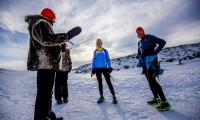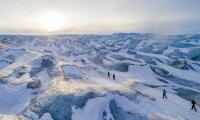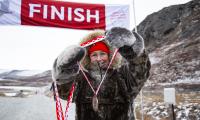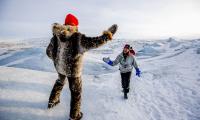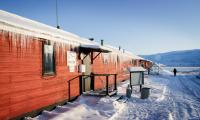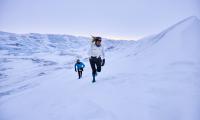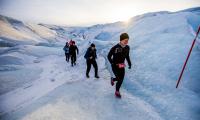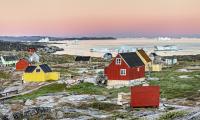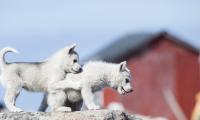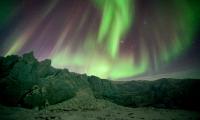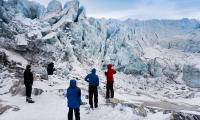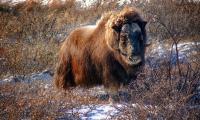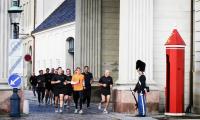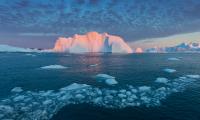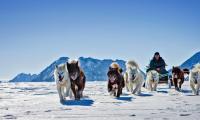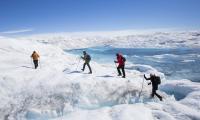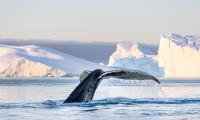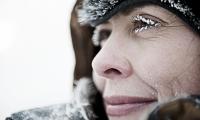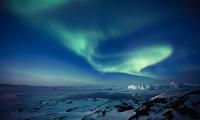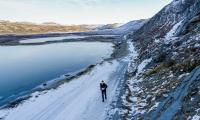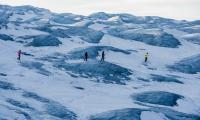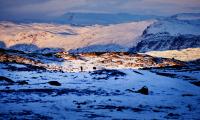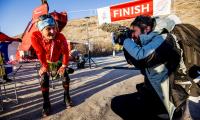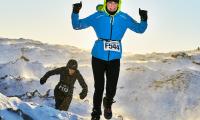Race Information
Here you will find all the important practical information about the race, such as rules and regulations, training, timing, race day support, clothing, weather and more. If you don’t find the answer you’re seeking, feel free to contact us with your question.
Topics are arranged in alphabetical order.
Clothing
Please note: Shoe spikes are mandatory for running on the ice.
In terms of clothing, there are no specific requirements, but the medical team and race officials do have the right to stop and take out a runner who is not dressed properly for the weather. We strongly advise that all participants follow the below recommendations and make sure it’s possible to cover all skin. The items we emphasize the most are: shoe spikes (mandatory), all-around wind protection, and no cotton!
Layers are key to a good race and to keeping you as dry and warm as possible. You need to be prepared for changing weather. It is always better to start out in a layer too much than one too little. Remember: it is easy to cool off if too warm, but hard to get warm if too cold.
How many layers you wear is an individual matter and weather dependent, but a minimum of 3 layers is recommended.
There are personal supply stations along the course where you can pick up dry and warm clothing – see “Supplies on Route." Wet and cold items can be dropped at any water station along the course.
We do not give specific recommendations on products, but have named some of the brands available in active polar clothing that we know have a good and well-tested product.
Base/Inner Layer (sweat transporting layer):
Must be a functional thinner layer that transports sweat away from your body (called moisture-wicking) and dries fast. Make sure it’s comfortable to wear and doesn’t restrict you in your movements.
Avoid base layers with zippers that touch the skin.
Check out: Peak Perfomance, Falke, Craft, Under Armour, Icebreaker, Salomon, Newline
Mid Layer (insulating layer):
Should be a loose weave fabric or fleece with additional thermal insulation thicker than your base layer. Again it’s important that it doesn’t restrict your movements, especially with the outer layer on top.
The mid layer should provide warmth and breathability. Again it’s important that moisture is transported to the outside/next layer. Some mid layers even have wind protection, but this is not a must as you won’t be running without your top layer when windy.
Check out: Montane, Craft, Icebreaker, Salomon, Newline
Top/Outer Layer (weather-protective layer):
The top layer can be divided into two categories: Soft shell and hard shell. Regardless of what you choose, wind protection is the most important thing. Water resistance is a benefit too in case it snows.
While soft shells are now being manufactured with better wind and water resistancy they’re still not as efficient as a hard shell. The hard shell on the other hand, does not have the same breathability as the soft shell, although development of vent zones does allow for more airflow and thus minimize the risk of wet and cold mid- and base layers.
In extreme wind conditions starting in both a soft and a hard shell can be advisable, but it is also very likely that you will soon be too warm and will need to drop one of them.
Check out: Montane, Craft, North Face, Peak Performance, Salomon, Newline
Remember: Cotton is your worst enemy when running in an arctic climate. Cotton retains water and will make you very cold, as well as rub your skin raw. Do not wear cotton clothing during the Polar Circle Marathon and Half Marathon. High-performance clothing will also decrease your chances of getting blisters and calluses. Merino wool is a potential option, as wool will keep you warm even when it's wet. Brand such as Icebreaker and Smartwool make perfomance-wool clothing.
Legs:
Three layers on your legs are likely to be too much. The top layer on your legs must have wind protection and preferably thermal functionality. A base layer under a winter tight will work if the tight has wind protection. Alternatively a normal winter running tight may work fine as base layer under a pair of windproof running pants.
Running without wind protection on your legs may cause frostbite on knees, thighs and other lower body parts.
Check out: Montane, Craft, Patagonia, Salomon, Newline
Gloves:
Again, wind protection is the most essential, but of course your gloves should be warm too!
Make sure your gloves aren’t too tight around your hands and fingers – it’s better for airflow between your skin and the fabric. Layers will be an advantage in very windy conditions with inner gloves under a warmer and looser pair of outer gloves or mittens.
Hand warmers are an option, but as we try to leave as little a footprint as possible on our race site we recommend the reusable solutions over the disposable versions.
Extra gloves can be placed at one or more of the personal supply stations, as especially the inner gloves tend to get wet.
Check out: Craft, Montane, North Face, Icebreaker, Salomon, Newline
Head and neck:
A winter hat is an absolute must. It should cover your ears too. Some prefer a functional moisture wicking hat while others opt for warmer traditional winter hats. A hat of 100% wool will have both features, but may be itchy for some people.
The neck should be covered with a scarf or a neck tube/buff. It’s important that the scarf/buff can be drawn up over the mouth and nose in case of strong winds. However, running with your nose and mouth covered for a longer time will cause condensation and make your face more prone to frostbite.
Balaclavas and buffs with air holes for mouth and nose are available, but even these will eventually turn in to an ice mask. If windy and necessary to cover your face make sure you actively remove the ice building up on your cover. A spare scarf/buff at the personal supply station is advisable. Star Wars fans may invest in a ColdAvenger.
The use of tape on cheek and nose is not recommended. There’s no evidence that this will prevent frostbites, but it will definitely prevent the medical team from seeing signs of frostbite.
Sunglasses or light ski goggles will be a relief in sunny, windy, and/or snowy conditions.
Feet:
For choices of shoes and anti-slip soles, please see “Shoes & Spikes” above.
Your feet are the least exposed part of your body as you’ll be constantly moving sending a lot of blood to your feet and toes. We do recommend, however, that you wear warm running socks, potentially with a thin liner sock underneath. Make sure the sock is high so there’s no open skin gap between sock and tights/pants. A spare pair of socks at the personal supply station is advisable.
If the ice sheet is covered in a thick layer of snow gaiters will keep it out of your shoes, but cheaper solutions like a plastic bags inside your shoe may do the trick. If you’re prone to blisters the plastic bag may cause too much friction.
Change of clothes:
Half marathon runners and marathon runners staying at the Old Camp should pack a small bag with extra clothes to be available at the finish line. Marathon runners at Hotel Kangerlussuaq and Polar Lodge can walk to their rooms and do not need to prepare a change of clothes.
Make sure you mark all your clothes and items with your name and/or bib number for easy identification. Clothes and items dropped at the water stations during the run will be taken back to the finish area at the end of the race. The race organisers cannot be held responsible for any lost or damaged items left along the route.
Cut-off Times
The time limit for the half-marathon is 4 hours.
The time limit for the marathon is 7 hours.
Runners still on the route after the cut-off times will be picked up by a race official or medical car and driven back to the finish area.
Distances & Polar Bear Challenge
The Polar Circle Marathon features a classic 42.195 km marathon and a 21.097 km half-marathon.
Are you as awesome as the Arctic Circle’s biggest predator? We introduced the Polar Bear Challenge for the very fit. Take on the challenge and run Saturday’s marathon and Sunday’s half marathon! Finish both races within the time limits and receive the Polar Bear Challenge medal in addition to the half-marathon and marathon medals.
Distance Change
It is possible to change the distance you originally signed up to run. Late changes to the Polar Bear Challenge, however, depends on availability.
Last chance to change distance is Friday at the race briefing, the day before the marathon.
It is NOT possible to sign up for the Polar Bear Challenge AFTER you have run the marathon. Polar Bear Challenge registrations must be done no later than Friday, the day before the marathon, but again depends on availability.
Distance changes received by email no later than 3 weeks before the race will be prepared in advance and your race pack will include the correct bib number. Later changes can only be done at the race briefing. You must bring your original race number!
Change of distance is NOT PERMITTED on Race Day.
Eligibility
Full marathon runners must be at least 18 years old on race day.
Half marathon runners must be at least 16 years old.
Polar Bear Challenge runners must be at least 18 years old.
Future Race Dates
The Polar Circle Marathon generally takes place on the last weekend in October.
The 2024 race will take place on October 26 and 27.
The 2025 race is scheduled for October 25 and 26.
Goodie Bag
All international participants will receive their race packs at Albatros headquarters the evening before the flight to Greenland - Wednesday at18:30.
Your bag will contain your race t-shirt, start number, and race belt, as well as information on the route, schedule, and itinerary.
Participants who are not able to attend the event at Albatros headquarters on Wednesday must pick up their race pack in Copenhagen Airport BEFORE checking in for the flight to Kangerlussuaq. Details will be advised in the departure letter.
Local runners must pick up their race pack at the race briefing Friday evening at Hotel Kangerlussuaq.
If you ordered spikes when booking these will be available when you arrive in Kangerlussuaq.
Medical Team
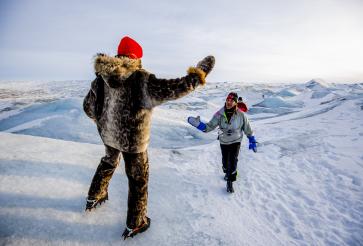
A team of Danish doctors will be present during inspection and race days. The medical team is ready in case of injury or severe exhaustion. A doctor will be present on the ice sheet as long as runners are on it. A doctor will be patrolling the route and a doctor will stand by in the finish area. If the medical team finds it necessary they can stop a runner and take him/her out of the race. Decisions on taking runners out of the race will only be done if the medical team believes there is a serious health risk in continuing.
The medical team can stop a Polar Bear Challenge runner from starting the half marathon if they deem the impact from the marathon has been too hard and poses a health risk for the runner. No refund is given in such cases.
Do not forget to drink water before and during the race. Running in the cold will not make you feel as thirsty as in warmer climates, but the route is still 42,195/21,097 kilometres long!
All decisions made by the medical team are final and not up for discussion.
Runners who wish to drop out of the marathon should go to the nearest drink station where sleeping bags will be available to keep you warm. Transport to the finish area will be arranged for all runners who leave the race, but please be aware there will be a waiting time.
If you take daily medicine prescribed by your physician or need any other medication, please inform the race doctors in advance by writing to marathon@albatros-adventure.com.
Merchandise
During the race briefing and race day, a variety of exclusive Polar Circle Marathon merchandise can be purchased, such as caps, shirts, and jackets.
Personal Belongings and supplies
Half marathon runners and marathon runners staying at the Old Camp should pack a small bag with extra clothes to be available at the finish line. Marathon runners at Hotel Kangerlussuaq and Polar Lodge can walk to their rooms and do not need to prepare a change of clothes.
Make sure you mark all your clothes and items with your name and/or bib number for easy identification.
At the start line you can drop warm jackets and other items that may be handy to keep warm until the start of the race. You can also drop clothes and other items at any water station.
Clothes and items dropped at the water stations during the run will be taken back to the finish area at the end of the race. The race organisers cannot be held responsible for any lost or damaged items.
It is possible to place personal supplies and extra clothing at selected water stations - three stations for marathon and one station for half marathon (see the route map for details).
Personal supplies that you want available on the route must be handed in at the start area. Remember to mark your supplies clearly with name and/or bib number.
Kindly be aware that that any special supplies like gels, energy bars and -drinks should be brought from home. If you have time in Copenhagen sports- and running shops here will have a variety of energy products, but you will not find such items in Greenland.
Please note that gels are likely to freeze unless worn inside of your clothes.
Photos and Certificate
Marathon Photos will take personal photos of all runners. The photos can be purchased after the race from www.marathon-photos.com
Your Finisher's Certificate will be available for free download.
Prizes and Awards
All finishers receive a medal. A small, symbolic prize is awarded to the top three finishers in each race (marathon, half marathon, and Polar Bear Challenge) in the male and female categories. Please note that there is no prize money.
Race Briefing
Race officials will provide all participants with a race briefing on Friday evening (the day before the marathon race), which will cover everything from a preliminary weather forecast to a brief presentation of the important route notes.
Race officials and medical staff will be present to answer any questions you may have. Official Polar Circle Marathon merchandise will also be available for purchase.
Race Officials Disclaimer
English-speaking race officials from Albatros Adventure Marathons™ are in charge of the event. The race officials reserve the right to change the course and other aspects of the race without advance notice.
Please note that all decisions made by the race officials and/or medical team are final.
By signing up for this event you agree to the Terms & Conditions of Albatros Adventure Marathons™.
Registration
Registration for the Polar Circle Marathon is done in combination with booking the 5-day tour package.
Race entry only is not possible for international runners.
Click here to register.
Additional information on ways to enter is available below, or here.
International Participants
For international participants, race entry is only possible in conjunction with a multi-day tour package. The packages include all the ingredients for a fantastic getaway: accommodation, social events, sightseeing, and select meals and transportation per the itinerary. Packages also generally include ample amounts of free time, during which you can choose to join organized excursions or explore the region at your own pace.
In one of the most remote corners on the planet, you can hunt for the northern lights or curl up in cozy Kangerlussuaq with a cup of strong Greenlandic coffee (a doozy of a drink with whiskey, Kahlua, and Grand Marnier). Come and be overwhelmed by the magnificence of the Greenland Ice Sheet while running the coolest marathon on Earth!
Residents of Greenland
Participants who meet the necessary Greenlandic residency requirements are eligible for local entry, which includes only the race.
Please note: If you are looking to enjoy an extended holiday in Kangerlussuaq and reside elsewhere in Greenland, it is certainly possible to join the standard international 5-day package.
As proof of eligbility, residents and citizens of Greenland must present a current, valid residency permit and/or employer certificate. Upon receiving your entry, we will contact you to request copies of your official documentation.
Registration Deadlines
Officially, registration closes one month before the tour package begins.
However, there are limited spaces and the Polar Circle Marathon sells out rapidly every year. To get the accommodation you prefer, we advise you to book quickly!
Route Map & Elevation Profile
For information on the marathon and half-marathon routes, start and finish line, drink stations and other course-related information, see Route & Elevation.
Rules & Regulations
Nordic walking and trekking poles are not allowed.
Safety Precautions
Race Precautions
A medical team is ready in case of injury or severe exhaustion. A doctor will be present on the ice sheet as long as runners are on it. A doctor will be patrolling the route and a doctor will stand by in the finish area.
A sweeper will follow behind the last runner throughout the race. On the ice sheet, a snow mobile is on standby in case of accidents or a rapid change in weather.
A bus will be parked just before the entry/exit to the ice cap, ready to warm up runners if necessary.
In case of strong winds all runners will be stopped before entering and after exiting the ice cap and checked for signs of frostbite.
Runners who wish to drop out of the marathon should go to the nearest drink station where sleeping bags will be available to keep you warm. Transport to the finish area will be arranged for all runners who leave the race, but please be aware that waiting time may occur.
Take extra precaution when running on the ice sheet. Fall injuries on the hard ice could mean your race is over.
Frostbite
Frostbite is a risk at the Polar Circle Marathon, but will cause no severe injury if treated correctly and in time. There are 3 degrees of frostbite to describe the duration and depth of the injury:
1) First degree frostbite signs are sensations of cold and pain and/or the affected skin turning white. First degree frostbite is only a superficial injury and can be treated by anyone, including yourself, simply by warming/thawing up the affected part of your body. If it’s not possible to go inside warm hands can thaw the frostbite, but remember to take off gloves and warm skin to skin. If your fingers are at risk they can be warmed against your stomach or in the armpits.
After thawing first degree frostbite the skin will be slightly red and may still feel “buzzy”, but as the blood is now streaming back it takes longer time for the same area to get frostbitten again. Eventually all signs of a first degree frostbite will disappear.
2) Second degree frostbite is deeper and develops blisters. If you have blisters anywhere on your body after finishing the race, don’t assume this is a normal friction blister, but go see the medical team and get the blister examined for being a possible frostbite. Treatment can be rather painful and last for several weeks. Permanent redness on the affected skin may occur as well as the area developing permanent intolerance to coldness.
3) Third degree frostbite is a very deep skin injury causing dead tissue. Instead of extreme white the skin can turn red and purple. A sense of numbness in the area is typical sign of third degree frostbite. Beware, however, that a finger with third degree frostbite can still move, although at reduced function, so don’t let this fool you into believing the injury is less serious.
The sooner frostbite is treated the better the chances of a good recovery so please don’t ignore any of the signs above.
A runner with second or third degree frostbite will not be allowed to continue and/or run the following day if signed up for the Polar Bear Challenge.
Frostbite is avoided by dressing well – see the Clothing section for more details.
Other Considerations
REMEMBER: It's important to avoid dehydration, so make sure you drink enough before the race and drink at all the water stations! Running in the cold will not make you feel as thirsty as in warmer climates, but the route is still 42.195/21.097 kilometres long!
Your skin will have more resistance towards cold when the natural skin grease is intact, so it is recommended not to shower in the morning of the race. As a minimum avoid washing your face with soap. A non-water-based lotion will also give a certain degree of protection if applied a couple of hours before going outside.
Keep moving your fingers while you run, clench your fists and make faces every once in a while.
If you take daily medicine prescribed by your physician or need any other medication, please inform the race doctors in advance by writing to marathon@albatros-adventure.com.
Shoes & Spikes
The Polar Circle Marathon can be run in a pair of normal running shoes or trail running shoes. It is, however, mandatory for all runners to wear spikes when running on the ice cap!
Spikes
'Spikes' (or anti-slip soles) refers to a rubber sole with steel points underneath that can be fitted to your running shoes and ensures a safe grip on ice. There are many different types of anti-slip soles, but some of those that will be approved for this race are: Kahtoola MICROspikes, LACD Snow Spikes and Grivel Ran.
Albatros Adventure Marathons™ offers the possibility to purchase proper spikes when booking the tour package. If you wish to do so, simply select the size you want in the booking form, and then you will receive your spikes upon arrival in Kangerlussuaq.
Start / Bib Numbers
You will receive your start number (also called bib number) in your race bag along with a race belt. The start number must be placed on the front of your body and be visible at all times during the race. As clothing layers may come on and off, we recommend that you use the race belt, but safety pins are also available. Polar Bear Challenge runners receive two numbers, one for each day, in case the conditions are too rough on the number sheet.
The start numbers are color coded according to the distance you are running.
Marathon numbers are black.
Half marathon numbers are red.
Polar Bear Challenge numbers are white.
A timing chip is placed on the back side of all start numbers. Do not bend or fold the start number as this may damage the chip, which will mean that your time is not recorded.
Time Taking & Results
The races will be timed by Ultimate Sport Service using BIB-chip. The BIB-chip is attached on the back of the bib number and will record each runners net finishing time. Do not fold or bend the bib number as it could damage the chip.
In the evening after each race, a complete result list is expected to be ready. There are no age categories.
Live results will be available from the Results page.
Weather
The weather in Greenland is always unpredictable!
Expect the temperature to be minus 15-10 degrees Celsius when the marathon starts. As the sun rises, the temperature will typically rise to minus 10-5 degrees Celsius. Snow may occur, but Kangerlussuaq is known for its relatively stable climate with little precipitation.
Wind changes are the unknown factor.
Strong winds can generate serious wind chill and are the most common cause of frostbite.
To be prepared for the weather, please carefully read the information in the sections on Clothing and Safety Precautions.

